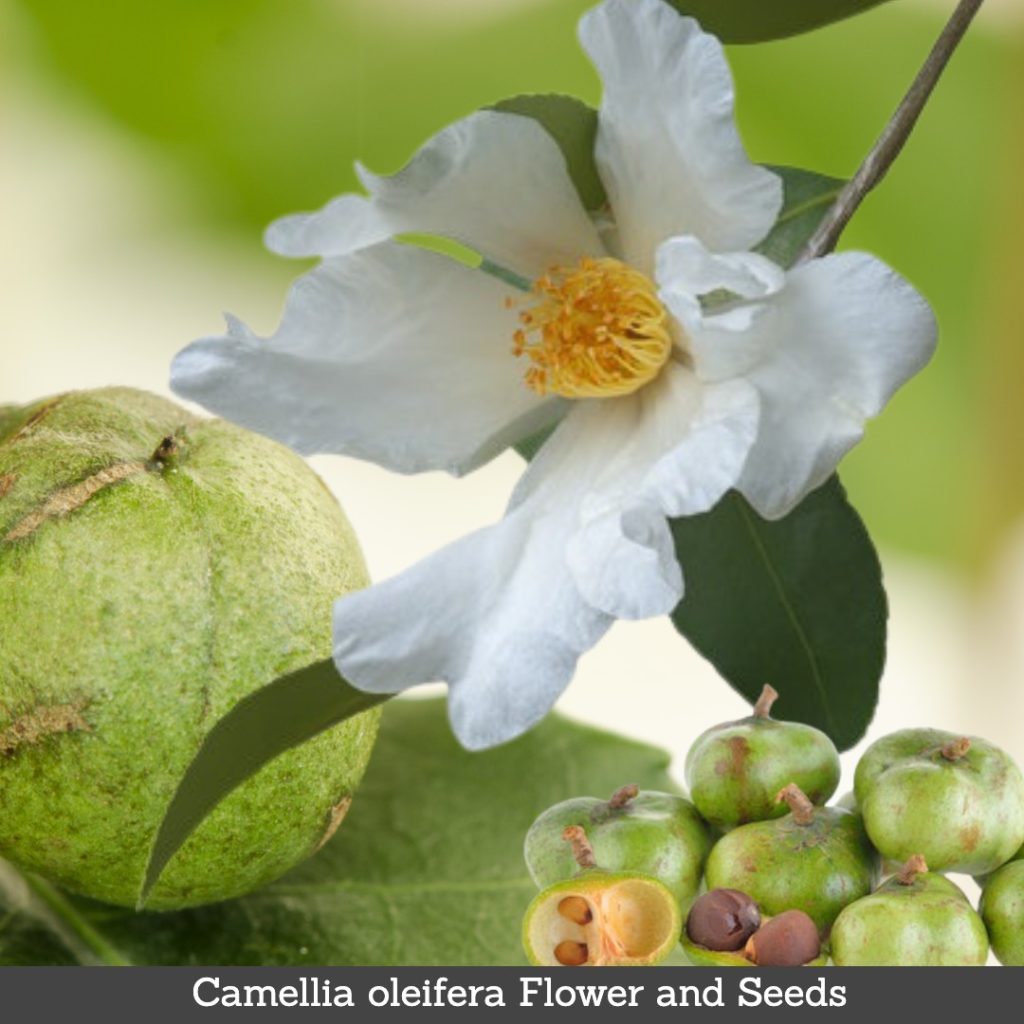As we move into 2021, I started thinking that a good way to start the new year is to “feed” your body better. This will ensure a stronger immune response through the winter season, and also help you with gut concerns, mood, sleep and mitochondrial health.
So I want you to start the new year with what I think is a fantastic, healthy oil. I like interesting “functional oils” as they’re called. Because I cook healthy foods so much, I love to explore and research spices, teas and oils. I have all kinds of oils here, including macadamia nut oil, avocado oil, olive oil, grape seed oil, black seed oil, and tea seed oil. The last one is where I’ll focus today. It’s a very interesting oil to me, and the flower is gorgeous!
Tea Seed Oil – you cook with it! It’s not an essential oil.
I’ve mentioned it many times before, as an ingredient in many of my recipes posted at my website (click on the Recipes tab). But what is it exactly? And why would I start the new year off with “tea seed oil” instead of New Year’s health resolutions?
First of all, I don’t think many of us want to deal with resolutions right now. Everyone is stressed enough, so I’ve decided to use this article to talk about a healthy oil that we can all begin cooking with. Doing so will help you each day of the year, and unlike resolutions, you will not bail on this after 3 weeks!
What is Tea Seed Oil?
Tea seed oil comes from the seeds of the Camellia oleifera plant, which is a cousin to Camellia sinensis. The latter provides us with leaves which we can turn into green tea, matcha, white tea, and oolong. The Camellia species of plants and flowers is native to Asian countries, like China, Hong Kong, S Korea, Singapore, Taiwan, and others. America simply doesn’t have these species, that’s why virtually all high-quality teas (and oils) are imported. We have other crops, but not these. (If you scroll to the bottom of my article, I have brands of this oil listed and their country of origin.)

Tea Seed Oil is extracted from the seeds of mature Camellia oleifera trees, not the flowers.
Tea seed oil is also called “camellia oil.” The flowers are gorgeous. Writing about camellia today with you reminds me of a murder-mystery novel I once read called, The Last Camellia (Sara Jio).
What are the health benefits?
Tea seed oil gives your body a refreshing clean “oil change.” Just like a car needs certain oils for its brakes and gears, your body needs certain oils to keep cell membranes healthy, cholesterol ratios in good balance and maintain a healthy, content mood. Oils contain a host of healthy vitamins, antioxidant enzymes, minerals and nutrients in them. That’s why they’re called “functional oils.” They are not just grease or fat used to keep the food from sticking to the pan. Oils impart health benefits, and some oils are not good for you.
So from now on, think of cooking oils like you would a dietary supplement. You can choose an oil by its nutrient profile so it nourishes your body the way a supplement does. Just like olive oil, tea seed oil has potent antioxidant compounds with extremely high levels of unsaturated fats.
It contains a similar fatty acid profile to olive oil too, however, it has more omega-3 fatty acids and less omega-6 fatty acids. It’s free of cholesterol. As for nutrients, tea seed oil boasts vitamin E, vitamin A, B vitamins, and minerals.
I see a lot of negative talk about omega-6 in many people’s blogs, but you do need some. It’s not a villain. If you take high dose EPA, you might tilt yourself completely out of balance! The topic of essential fatty acids is not covered here in depth, but I want you to know it’s about balance in the human body. You need some omega-6, they are not “bad.”
It is high in oleic acid. In fact, according to this ARTICLE, tea seed oil consists of more than half oleic acid (about 56%) and the rest of it is linoleic acid (about 22%) and finally, some linolenic acid. This profile is good for your heart. Oleic acid-rich foods and oils are often talked about for preventing heart disease, supporting diabetes and reducing cholesterol.
After comparing the nutritional profiles of both, tea seed oil has more monounsaturated fatty acids than olive oil, and fewer saturated fats. Good! It’s free of cholesterol.
As for nutrients, tea seed oil boasts a lot of vitamin E, vitamin A, B vitamins as well as minerals. These include natural calcium, magnesium, phosphorus, iron, and manganese. Manganese is a critical cofactor for hundreds of enzymatic reactions in your body, as well as the formation of S.O.D., a strong antioxidant we need for survival.
Antioxidants
Tea seed oil provides incredible antioxidant protection too, and it’s not lost when you cook this oil. It has a lot of B-carotene, vitamin E and other polyphenols. Tea seed oil contains powerful antioxidants called “catechins” which is exactly why people drink so much green tea. They’re after the catechin! So using tea seed oil is another method of consuming these strong, anti-inflammatory benefits.
Catechins reduce the formation of potent free radicals called ROS (reactive oxygen species). It’s the ROS that wreak havoc on our cells and cause pain. Antioxidants like Superoxide Dismutase (S.O.D), glutathione and catalase help to neutralize those ROS before they hurt your body. Something as simple as an oil substitute in your kitchen can protect your body so much! As for studies, there are many that show how catechins like EGCG (the most famous one!) reduce blood pressure, support arterial health and cause apoptosis (helps with cancer spread). By using Tea Seed Oil you get about the same benefits from EGCG as you do drinking green tea.
One Useful Major Difference
One major difference with olive oil is that tea seed oil has a high smoke point, so you can cook and grill with it! It’s something like 485 degrees. Both olive oil and coconut oil will rapidly degrade and create pro-oxidants if you heat it that high! So tea seed oil is a great substitute to bake, sauté, fry and grill with. You may be interested in reading my other article, The Best and Worst Oils to Cook With.
FYI, when I say “smoke point” I am referring to a well-documented temperature at which an oil begins to give off smoke. It’s telling you that it is now breaking down, and the flavor is degrading. The oil is losing all of its innate nutritional value and may undergo a color change. That’s the reason olive oil is supposed to be used as a finishing oil, or salad dressing, or cooked on low temperatures only. You shouldn’t be grilling or baking with it. With tea seed oil, you don’t have to worry about heat damage at all.
You can see why I like this oil. By the way, I’m in no way connected to anyone who makes this oil or sells it or anything like that. I just love it and want to share my findings with you. So as the new year rolls in, doing little tweaks such as oil upgrades, and salt upgrades and even changes to your flour (using gluten-free flours) do so much to improve your health that is ‘unseen’ at first. But over time, these tweaks and edits impact your immune system as well as your mood, heart health and blood sugar.
So this year, instead of making a hard resolution, just resolve to give your body an oil change!
What Does it Taste Like?
It has a light flavor that will enhance recipes and I love the pale green to yellow color. It smells very mild, it will not overpower you, or any recipe the way other oils do. It does not impart any flavor, nor does it taste bitter the way that some green teas do. With coconut oil, you can taste it… but with tea seed oil, there is no flavor added to a recipe. I often use it for salad dressing, marinades, or drizzling over salmon. When Sam grills zucchini for me, I drizzle it on the raw vegetables too. You can usually substitute tea seed oil instead of any other oil. It’s great as a finishing oil too because of the high antioxidant profile. If you don’t like to drink green tea, you can use the tea seed oil.
An Added Perk
Sometimes in the winter, my heels get dry and I like to rub an oil on them before putting on my socks. I usually use jojoba oil but once I ran out, and I used tea seed oil and noticed it acted like a moisturizer and immediately soothed my dry, itchy heels that day. I could see how it might be useful when used for very dry skin, mild itchy rashes from psoriasis/eczema, scars, or even a dab to the lips when they’re chapped. Studies are available on the skin-promoting effects of tea seed oil, and many people have tapped into the dermal protection that this oil offers. Because of its powerful antioxidant and anti-inflammatory profile, it does double duty: it is good in the kitchen and good for certain skin problems.
See below for my cautionary comments.
Caution
Everyone is on a budget these days, and I understand that. I just want to make a comment about repeatedly heating up the same cooking oil when you make food, for example French fries. This is a regular practice for some people to save money but it’s not a good idea. Because tea seed oil has a high smoke point, and you can cook with it at high temperatures, you may be tempted to re-use the oil over and over. Do not do this with any oil.
STUDIES have shown that this is a harmful practice. It creates a high level of peroxides, and you may not have enough Catalase enzyme to neutralize the peroxides that you spawn when you repeatedly heat the same oil over and over. It alters an oil’s antioxidant effect. If I could have a word with big-name fast-food places I would tell them this information because I doubt they change the deep fryer oil every single time. In animal studies, there was damage to the colon of rodents after they consumed oil that had been repeatedly heated 3 times. Colorectal cancer cases are on the rise, and this is part of why I’m telling you. This year, about 53,200 people have died of this, and it is the third most commonly diagnosed cancer in men and women combined in the U.S.
One more thing to consider is shelf life. You cannot keep “functional oils” such as this for years. In fact, after opening them, they may go rancid after a few months. It’s the same with olive oil and other edible oils. You would not necessarily “see” this degradation visually – unless there’s a color change in the oil, so keep it in mind. Tea seed oil has about the same shelf life as olive and avocado oil, and it’s definitely shorter than vegetable and canola oil (two popular oils I do not use or recommend).
According to some data from a researcher in India, “Repeated heating of oils at high temperatures (160–190 °C) over a long period of time predisposes the oil to thermal oxidation, hydrolysis and polymerization with a configuration change of fatty acid from cis to trans isomers and accelerates the formation of oxidized and polymerized lipid species in the frying medium.”
So my advice to those of you who love fried foods, just heat your oil once in the frying pan, then dispose of it.
Where to Find Your Favorite Oils
The oils mentioned in my article are easy to find at specialty shops, however call in advance because they may be out of stock, or for that matter out of business now! If you prefer to shop online, there are several e-tailers that might have it. Below you will find a list of online sellers for my favorite olive oils and tea (camellia) tea seed oil.

Tea Seed Oil
Arette Tea Seed Oil – is the most popular brand on Amazon and the one that I’m currently using (whenever I use tea seed oil). It is cold-pressed, and sold in a glass bottle and like many camellia plants, they are native to Asia. This particular brand is a product of China, sourced by Arette Foods, Inc., which is USA-based. It is certified organic, and has an EXP date on it.
Arette Tea Seed Oil with GREEN TEA – This is also from Arette, similar to the above, however, it contains some steamed green tea (sencha) in it. This means it has additional catechins such as EGCG. I’ve never tried it but I want to.
Sunplan Organic Camellia Oil – This product comes from Hong Kong, another Asian country where the Camellia plant is native. It is 100% USDA organic camellia oil. It is “cold pressed” from all-natural camellia tea seed.
Nubeleaf – sold in big metal 1-gallon containers, this is another brand you can consider if you need a lot of it! It’s $99 for this so unless you use a lot of it, I don’t think it’s the best choice simply because it will not keep fresh for more than a few months. FYI, this is a product of China.
Camellia Seed Oil – sold by Mountain Rose Herbs, this brand of tea seed oil is used for cosmetic purposes, like for skin concerns and massage oil needs. You can use it as a carrier oil for essential oils, or add it to your shampoo. It can revitalize hair and skin. The beautiful oil is sourced from Denmark –the same country where the most exquisite tulip farm in the world is!
By the way, if stored in a cabinet or closet, with the cap tightly closed, you can keep a cosmetic oil such as this for a long time (years) without it expiring. It won’t degrade as quickly as your cooking oils.
SVA Organics Camellia Oil – another cosmetic oil made in India, this is a small 4oz bottle. This is tea seed oil but it’s not cooking oil, it can be added to your cosmetics, or used directly on the skin. It has a 4.7 average star review on AMAZON. If stored properly, you can keep a cosmetic oil for a few years without worrying too much. It’s not going to go rancid quickly the way a cooking oil will.
Olive Oil
My 3 favorite brands come from Greece, where the Greek island of Ikaria is. That’s a longevity BLUE ZONE, and statistics show very few cases of Alzheimer’s and dementia. One theory is the olive oil, olive tree farms are abundant there! The oils I mention below are not ‘cut’ with cheaper oils, a common undisclosed practice among olive oil farmers, that’s why so many of them are inexpensive (they may not be pure!). Genuine oils are more expensive. Koroneiki olives are considered the QUEEN of olives and the best companies source oil from this type of olive. Even though there are terrific oils from all over the world, I like these brands a lot:
Kouzini Olive Oil – Not mixed or adulterated or ‘cut’ with cheaper oils, this brand of olive oil comes in several sizes/flavors and packaging. It is non-GMO verified and comes from Greece, from the Peloponnese area. Extracted from “Koroneiki” olives, this has a nice flavor, pours easily and comes from a family-owned farm. It has low acidity.
Thea Olive Oil – The special prized “koroneiki” olives are handpicked and harvested from a family-owned grove in Kalamata Greece. Olive oil is considered an essential dietary staple for the people who live the longest. It is recognized worldwide as one of the preferred olives for olive oil production. This olive variety is native to the “Peloponnese” part of southern Greece. Extra virgin olive oil (EVOO) is 100% pure. It has low acidity.
Ellora Farms Olive Oil – Ellora Farms produces oils that are 100% cold extracted or from first cold press of the Koroneiki variety olives. It is unrefined and unfiltered and the olive farm is family-owned. This oil is certified by the European Union. It has low-acidity.

Suzy Cohen, has been a licensed pharmacist for over 30 years and believes the best approach to chronic illness is a combination of natural medicine and conventional. She founded her own dietary supplement company specializing in custom-formulas, some of which have patents. With a special focus on functional medicine, thyroid health and drug nutrient depletion, Suzy is the author of several related books including Thyroid Healthy, Drug Muggers, Diabetes Without Drugs, and a nationally syndicated column.

